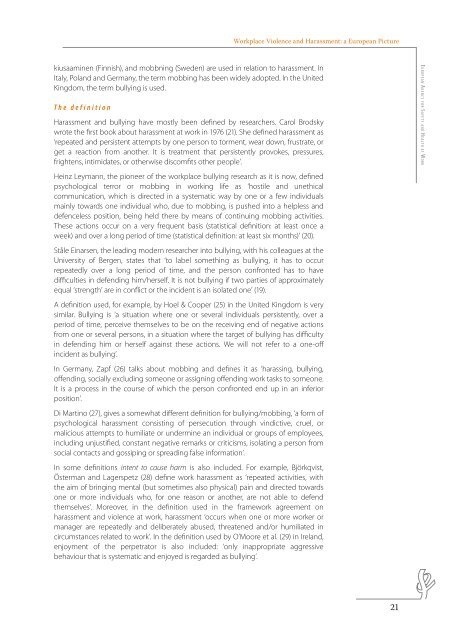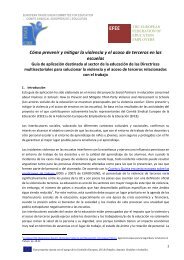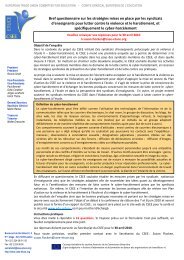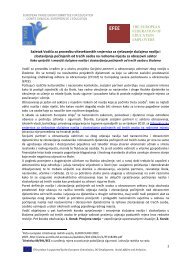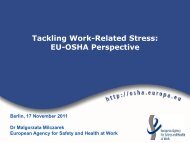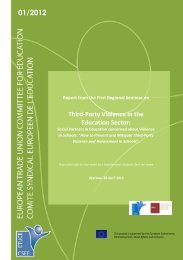Workplace Violence and Harassment: a European Picture
Workplace Violence and Harassment: a European Picture
Workplace Violence and Harassment: a European Picture
Create successful ePaper yourself
Turn your PDF publications into a flip-book with our unique Google optimized e-Paper software.
<strong>Workplace</strong> <strong>Violence</strong> <strong>and</strong> <strong>Harassment</strong>: a <strong>European</strong> <strong>Picture</strong>kiusaaminen (Finnish), <strong>and</strong> mobbning (Sweden) are used in relation to harassment. InItaly, Pol<strong>and</strong> <strong>and</strong> Germany, the term mobbing has been widely adopted. In the UnitedKingdom, the term bullying is used.The definition<strong>Harassment</strong> <strong>and</strong> bullying have mostly been defined by researchers. Carol Brodskywrote the first book about harassment at work in 1976 (21). She defined harassment as‘repeated <strong>and</strong> persistent attempts by one person to torment, wear down, frustrate, orget a reaction from another. It is treatment that persistently provokes, pressures,frightens, intimidates, or otherwise discomfits other people’.Heinz Leymann, the pioneer of the workplace bullying research as it is now, definedpsychological terror or mobbing in working life as ‘hostile <strong>and</strong> unethicalcommunication, which is directed in a systematic way by one or a few individualsmainly towards one individual who, due to mobbing, is pushed into a helpless <strong>and</strong>defenceless position, being held there by means of continuing mobbing activities.These actions occur on a very frequent basis (statistical definition: at least once aweek) <strong>and</strong> over a long period of time (statistical definition: at least six months)’ (20).Ståle Einarsen, the leading modern researcher into bullying, with his colleagues at theUniversity of Bergen, states that ‘to label something as bullying, it has to occurrepeatedly over a long period of time, <strong>and</strong> the person confronted has to havedifficulties in defending him/herself. It is not bullying if two parties of approximatelyequal ‘strength’ are in conflict or the incident is an isolated one’ (19).A definition used, for example, by Hoel & Cooper (25) in the United Kingdom is verysimilar. Bullying is ‘a situation where one or several individuals persistently, over aperiod of time, perceive themselves to be on the receiving end of negative actionsfrom one or several persons, in a situation where the target of bullying has difficultyin defending him or herself against these actions. We will not refer to a one-offincident as bullying’.In Germany, Zapf (26) talks about mobbing <strong>and</strong> defines it as ‘harassing, bullying,offending, socially excluding someone or assigning offending work tasks to someone.It is a process in the course of which the person confronted end up in an inferiorposition’.Di Martino (27), gives a somewhat different definition for bullying/mobbing, ‘a form ofpsychological harassment consisting of persecution through vindictive, cruel, ormalicious attempts to humiliate or undermine an individual or groups of employees,including unjustified, constant negative remarks or criticisms, isolating a person fromsocial contacts <strong>and</strong> gossiping or spreading false information’.In some definitions intent to cause harm is also included. For example, Björkqvist,Österman <strong>and</strong> Lagerspetz (28) define work harassment as ‘repeated activities, withthe aim of bringing mental (but sometimes also physical) pain <strong>and</strong> directed towardsone or more individuals who, for one reason or another, are not able to defendthemselves’. Moreover, in the definition used in the framework agreement onharassment <strong>and</strong> violence at work, harassment ‘occurs when one or more worker ormanager are repeatedly <strong>and</strong> deliberately abused, threatened <strong>and</strong>/or humiliated incircumstances related to work’. In the definition used by O’Moore et al. (29) in Irel<strong>and</strong>,enjoyment of the perpetrator is also included: ‘only inappropriate aggressivebehaviour that is systematic <strong>and</strong> enjoyed is regarded as bullying’.E u r o p e a n Ag e n c y f o r Sa f e t y a n d He a l t h a t Wo r k21


